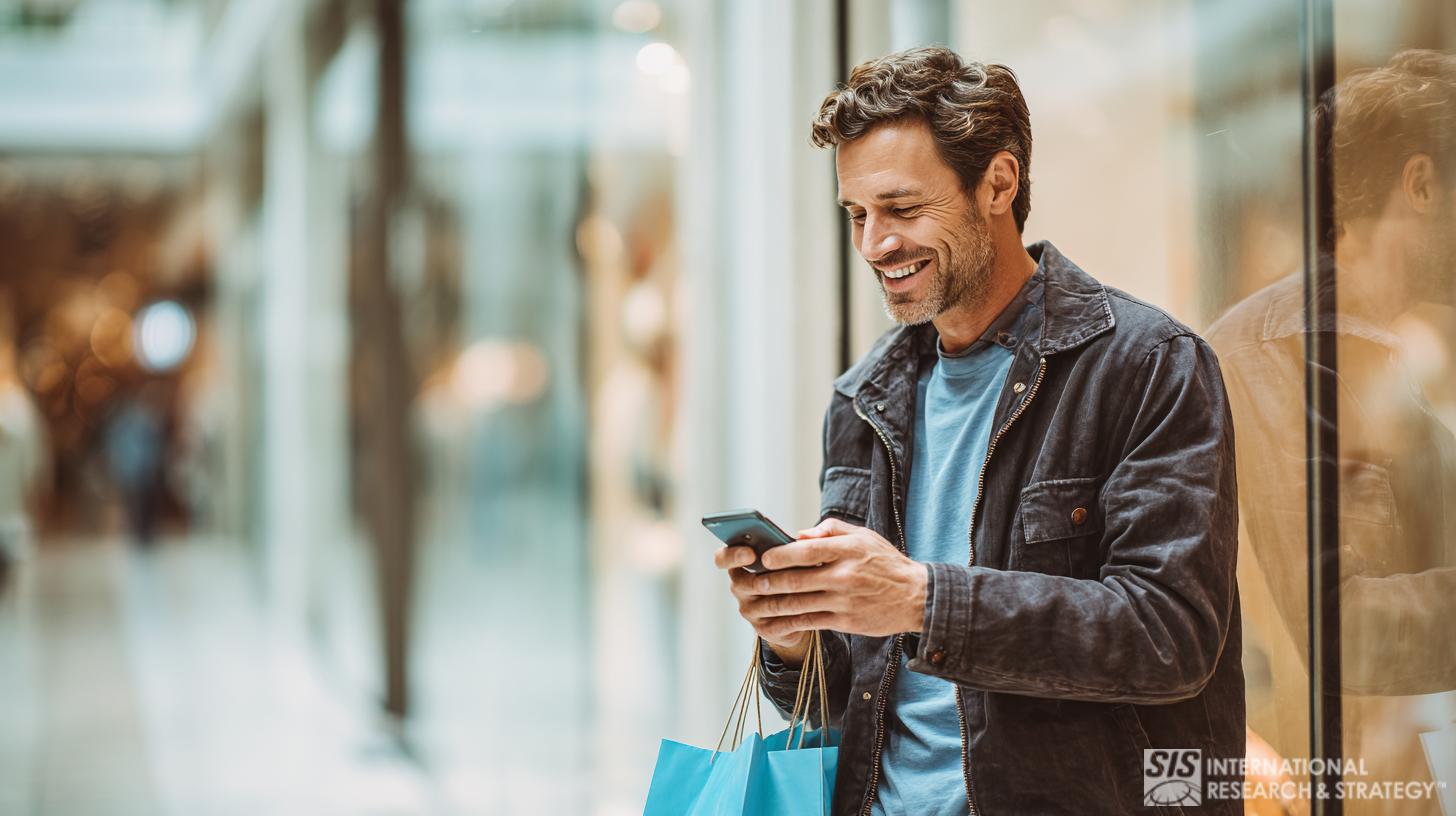The Future of Retail
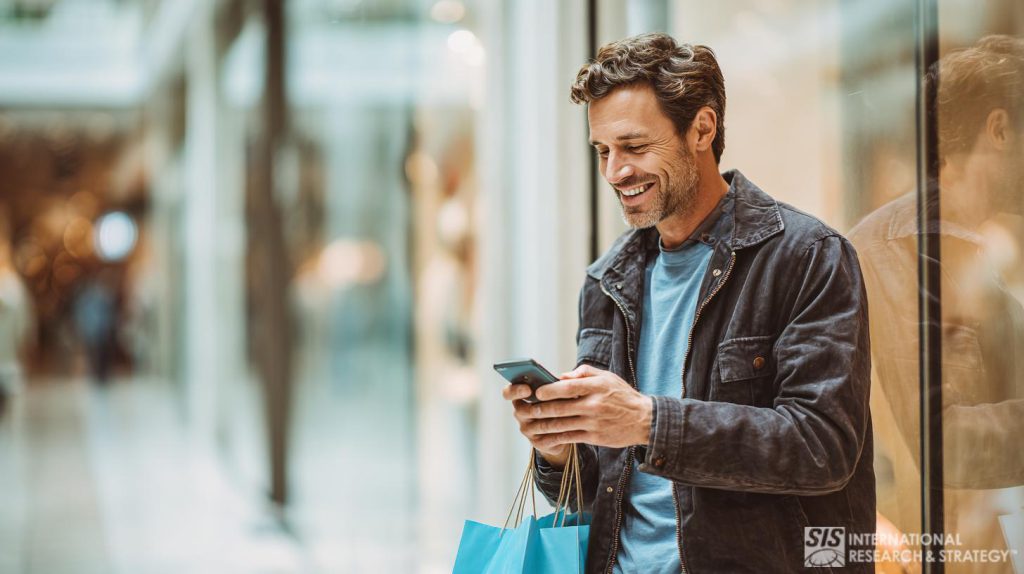
The future of retail isn’t just about new technology or flashy gadgets. It’s about fundamentally reimagining how you connect with customers, deliver value, and build lasting relationships in an increasingly digital world.
A shopper crosses the threshold of a store and, almost instantaneously, their smartphone lights up with discounts tailored to their previous purchases, emotional tone, and the drizzle falling outside. It feels like a scene ripped from a sci-fi blockbuster, yet similar exchanges are already routine on the sales floor.
Retailers planning for the near future are no longer content with making small adjustments; they analyze their certainties, gamble on unproven ideas, and actively trade comfort for insight.
تable of Contents
✅ Listen to this PODCAST EPISODE here:
Why Is The Future of Retail So Important?
The retail landscape has never changed this fast. Ever.
It’s a strange time to be in business. Customers want everything, yesterday. Tech vendors, eager to win attention, keep slashing prices. Freight lanes wobble between logjam and smooth delivery, leaving everyone guessing.
The winning playbook now reads less like a corporate manifesto and more like a science fair: try fast, learn faster, repeat. Square footage and splashy noise matter less than reflexes and relevance. Customers vote with clicks and gut feelings, so the most trustworthy option usually takes the cake.
C-suite veterans must learn to read a future still blurry at the edges. Those who play catch-up will watch others bag the easiest bargains. Visionary brands are already parking dollars in murky corners-quirky last-mile ideas, half-formed data experiments-because tomorrows winners staked claims before the map was drawn.
Figure 1. Retail Sales Distribution by Channel
Key Insight: Despite digital transformation, physical stores remain dominant, accounting for over 4 out of 5 retail sales. However, e-commerce continues growing faster, indicating the importance of omnichannel strategies.
What’s Changing: The Retail Disruption Curve
Four huge forces are taming the future of retail, and they arent waiting on anyone.
✔️ AI has jumped the experimental fence and moved into everyday operations. Predictive algorithms quietly steer inventory fleets while machine-learning engines fiddle with prices so the shelf never looks empty.
✔️ Digital supply chains have ditched their back-office cloak and stepped into the spotlight. With live dashboards, customers can now watch everything from lumberyard crates to doorstep deliveries, and that kind of visibility calms jitters when trouble strikes.
✔️ Greenness is no longer a glossy sticker; it sits on the spine of the product. Millennials and Gen-Z scan a brands carbon plot line before scanning their credit cards. Honest carbon ledgers, fair-trade origins, and renewal-based farming have become the bare minimum for shelf space.
✔️ Consumer behavior shifts happen faster than ever before. A meme born at breakfast can flip sales charts by lunch the next day. Retailers that wait for quarterly analytic reports are already watching competitors scoop the prize. Only systems sniffing, sorting, and serving up product tweaks in near-real time stay in the picture.
The Gen Z and Gen Alpha Revolution
Gen Z and Gen Alpha don’t just want different products – they want completely different shopping experiences.
People today want shops to know their tastes the moment they walk in-yet somehow feel as if they’re not being watched. المستهلكين want companies to talk about what they really believe, not recite another slick slogan. They drift between an Instagram feed, a curbside pickup, and an in-store queue without a hitch, and the journey had better look the same at every stop. If a brand can nail that rhythm and still hold true to its stated values, shoppers will gladly hand over extra cash again and again.
Retailers looking ahead have to reckon with a crowd that has never known a world without a screen in their pocket. Instant mood swings- and even quicker search bar taps- set the pace. Classic point schemes ring hollow to these customers, as do tired banners shouting about one-off sales, and call-center scripts that sound like a robot rehearing lines.
How The Future of Retail Solves Strategic Challenges
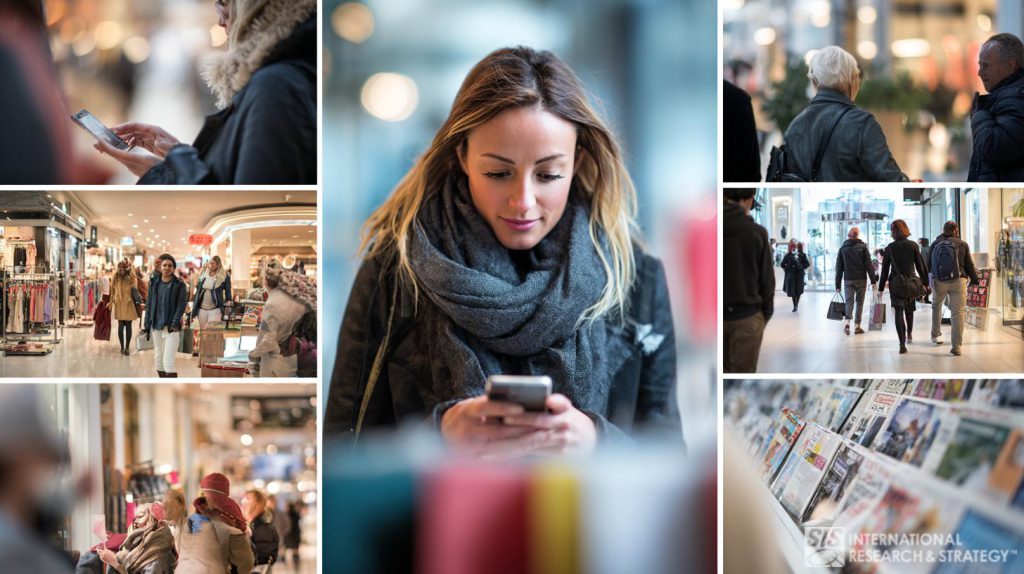
Retail leaders have wrestled with the same headaches for years; their wish list keeps getting longer. The next wave of technology is finally set to train its sights on those age-old complaints.
✔️ AI fine-tunes stock levels by forecasting which items will be hot or cold months down the road. That surge in precision can drop write-offs, lift margins, and make shoppers feel that the shelves actually carry what they expected to find.
✔️ When a personalization engine sorts through prospects and nimbly surfaces the ones most likely to buy, the cost of landing a new customer drops like a stone. One well-timed message to a micro-segment can outshine a scattershot ad buy that leaves everyone guessing about returns.
✔️ Routine chores drag employees down, but if software handles the clicking and copying, people can chat, solve problems, and show a bit of flair. Retail’s next chapter isn’t swapping humans for machines; it’s giving humans fewer hassles so their strengths get louder.
✔️ A screen that updates every few minutes lets a buyer spot a looming bottleneck instead of scrambling after it hits. Supply chain masters work the problem before it gets into a truck; they catch the ripple and steady the water before anyone even notices.
Table 1. The Future of Retail Transformation
Key Insight: The data reveals that successful retailers are investing simultaneously in AI-powered personalization, sustainable practices, and omnichannel integration. Companies that excel in all three areas achieve significantly higher customer retention rates and revenue growth compared to those focusing on single initiatives.
The Next Consumer Mindset
Forget everything you know about customer loyalty. The future of retail operates on completely different principles.
From Brand Loyalty to Value Alignment
Most people no longer buy from the same brand out of routine; they look for labels that mirror their beliefs, back the issues that matter to them, and show a real willingness to make things better. That demand for values-driven shopping forces companies to rethink everything from their public story to the quiet shape of their daily operations.
Shoppers are increasingly aware of purpose and can detect insincerity from miles away. Many will spend a few minutes digging into a brands practices, tracing a product back through its supply chain, and letting that research tip the scales toward purchase-or away from it. Authenticity, in other words, must sit at the very center of the business plan.
Instant Personalization and Zero-Friction Experiences
Customers expect every interaction to feel custom-built for them. Not eventually. Immediately.
The future of retail will deliver personalization so seamless that customers forget they’re experiencing it. Product recommendations that feel intuitive. Pricing that adapts to individual circumstances. Customer service that anticipates needs before they’re expressed. This level of personalization requires sophisticated data strategies and AI capabilities that many traditional retailers haven’t developed yet.
Zero-friction experiences mean removing every unnecessary step, question, and delay from customer interactions. One-click purchasing. Automatic reordering. Predictive customer service. Voice-activated shopping. The companies mastering these experiences aren’t just more convenient – they’re becoming essential parts of their customers’ daily routines.
Figure 2. Revenue & Efficiency Gains from AI Implementation
Revenue & Efficiency Gains from AI Implementation
Percentage improvements across key retail functions
Key Insight
Product recommendations and personalized marketing deliver the highest ROI, both achieving 30% improvements. Supply chain optimization and pricing strategies show consistent 15% gains, while overall AI adoption drives 19% revenue increases across retail operations.
تجربة الزبون
77% of companies using AI personalization report increased market share, while 74% of consumers won’t complete purchases without personalization.
كفاءة العملية
AI enables 35% inventory reduction, 65% service level improvements, and 50% lower customer acquisition costs through intelligent automation.
The Rise of Co-Creation
Retail is shifting toward a model where shoppers are part of product development and experience design. We’re not talking about quarterly مجموعات التركيز or stale online surveys; this is live, rolling collaboration. Emerging brands are already hosting forums and pop-up workshops that let customers experiment, remix, and celebrate the merchandise in plain view. User photos, quick polls, and plain chatter feed back into the design loop almost instantly.
The approach is effective because it meets fundamental human needs for agency, recognition, and belonging.When somebody sees their idea land in a finished sneaker or app update, the emotional tie is suddenly deeper than points on a loyalty card.
Retail Vision & Scenarios

Three scenarios will define the future of retail. Smart executives are preparing for all three simultaneously.
AI-Native Retail: When Algorithms Anticipate Everything
Picture a future store that seems to read your mind. Long before you realize your cleaning spray is running low, a brainy algorithm tracks your web clicks, weather spikes, and holiday habits, then slides a replacement into the checkout queue.
Back-end algorithms, scanning everything from last month’s birthday binge to this week’s rainy-day cravings, silently queue up the following order so nothing sits empty on the counter. Meanwhile, mock-up twins of your shopping habits take each new product for a test drive long before any factory line hums to life. An automatic stock-balance engine keeps warehouses on a steady diet of refill cycles.
In that future shopping landscape nothing waits for you to point; it simply appears. Packages land on the porch that your brain never even penciled in. Shelves sit neither bare nor buried with extras, and sale banners pop up the moment they stop looking like hard-sell noise.
Strategic question for your C-suite: How would your competitive position change if AI could predict customer needs more accurately than customers themselves?
Phygital Ecosystems: Where Online and Offline Become One
One moment you’re flicking through an online catalog, the next you’re picking up the same item in a brick-and-mortar aisle, and before bedtime a voice assistant seals the deal. The border between looking at a screen and touching a shelf practically fades away.
AR graphics hover over the wine label at checkout, whispering tasting notes and pairing ideas as if the vineyard stepped alongside you. A virtual loft of endless sneakers spins in mid-air when shelf space simply runs out, showing every style that isn’t even stacked behind glass.
Retail is evolving into a smooth narrative that rewrites itself based on where you are and what mood you’re in. Store staff tap a tablet and see last week’s returns, delivery times, and size swaps all in one glance. Your phone nudges open an extra aisle of tailored discounts when you cross the threshold. Every box, label, and tag quietly links back to the cloud, so the coat you buy today can already schedule its first cleaning tomorrow without another thought.
Sustainable-First Brands: Carbon Transparency as Competitive Advantage
Environmental responsibility becomes the primary differentiator between brands.
Carbon dashboards now tell shoppers the real footprint packed into each item in their cart. Hand-in-hand, Ethical AI quiets the leftover prejudices in recommendation engines so the same old blind spots don’t get recycled. Regenerative supply lines, meanwhile, are shifting from doing less harm to actively greening the soil and the waterways they touch. Because of that honest conversion, buyers today are willing to spend a little extra on labels that can prove they’ve made things better, not just quieter.
Brands have learned that living sustainability in every meeting note and budget spreadsheet pays off louder than flashy ads ever could. Nobody cares about the glossy leaf icons anymore; raw supply-chain maps are the new badge of honor. Purchase behavior now leans away from short-term profit promises and toward anything with a visible emission dip. Wall Street has started giving just as much weight to tonnage saved as it does to revenue growth.
Strategic question for your C-suite: How would your business model change if environmental impact became as important to customers as price and quality?
Imperatives for CMOs & Leadership
The future of retail demands immediate action on four critical fronts. Delay any of these, and you risk falling permanently behind.
Own the Data Loop
Third-party cookies are gradually being shelved, privacy rules keep getting stiffer, and shoppers now expect brands to guard their personal information as if it were gold. The retailers most likely to thrive tomorrow are the ones pouring energy into one-to-one relationships that churn out fresh, reliable data every day.
Success hinges on gathering information in a fair way, sifting through it with real intelligence, and acting on the findings before the moment passes. That blends sharp technology with a bigger, bolder strategy, new skills, fresh alliances, and compelling offers are all part of the picture.
Design for Fluid Loyalty
Traditional loyalty programs don’t work anymore. The future of retail requires new approaches to customer engagement.
Shoppers are tired of bonuses that just shave a few pennies off the next bill. They want something richer, a membership that pays them back with stories they can tell later. Many people now join brands hoping to meet fellow fans, not hoping to be advertised to. Real loyalty kicks in when a company aligns its mission with the values its best customers already live by.
Merchants who pay attention have already swapped dusty points ledgers for fixes that feel personal. Instead of a predictable tier climb, they release perks that lighten daily routines and even lift a mood. The payoff is simple: once a buyer feels seen, the checkout button is almost automatic.
Empower with AI, Don’t Just Automate
The biggest AI mistake is using it to do the same things faster instead of doing entirely new things.
Retail is tipping toward a future where AI turns everyday transactions into something that almost feels like sorcery. Shoppers see advice that lands just right and support people who already know what they need before they even say it. Shelves stay stocked on the right items at the right moment because the math fixes trouble before it shows up in the sales report.
Chasing tidy spreadsheets alone won’t get the job done. Organizations must let the technology inject fresh smarts into their bones, sparking experiences and structures nobody else can copy. The goal is to wake up to new models and real, lopsided advantages every few quarters.
Figure 3. AI in Retail Evolution: From Algorithms to Intelligence
AI in Retail Evolution: From Algorithms to Intelligence
Foundation Era (2000s-2016)
Intelligence Scale (2016-2023)
Generative Revolution (2023+)
Real-World AI Applications in Retail Today
AI Intelligence Evolution: The retail industry has progressed from simple “customers also bought” algorithms to sophisticated AI systems that understand context, predict needs, and generate personalized content in real-time. With 87% of retailers already using AI and the market projected to reach $45.7 billion by 2032, artificial intelligence has become the cornerstone of competitive advantage in modern retail.
Invest in Culture and Technology Equally
Retail tomorrow will belong to companies that shift direction as easily as they launch a fresh app. Fearless experiments, real-time learning, and a constant readiness to pivot will be the table stakes. That forces them to rethink hiring, retrain crews continuously, and break the silos that smother bold ideas.
Bright teams must blend empathy for shoppers with a sharp grasp of algorithms; they arent two separate worlds anymore. Leaders have to pair big-picture strategy with the guts to fund the next bet, even if it looks messy at the start. Cultures that toast smart failures and sprint to the next version are the ones stacking small wins into outright victory.
How to Integrate Market Research into Business Strategy
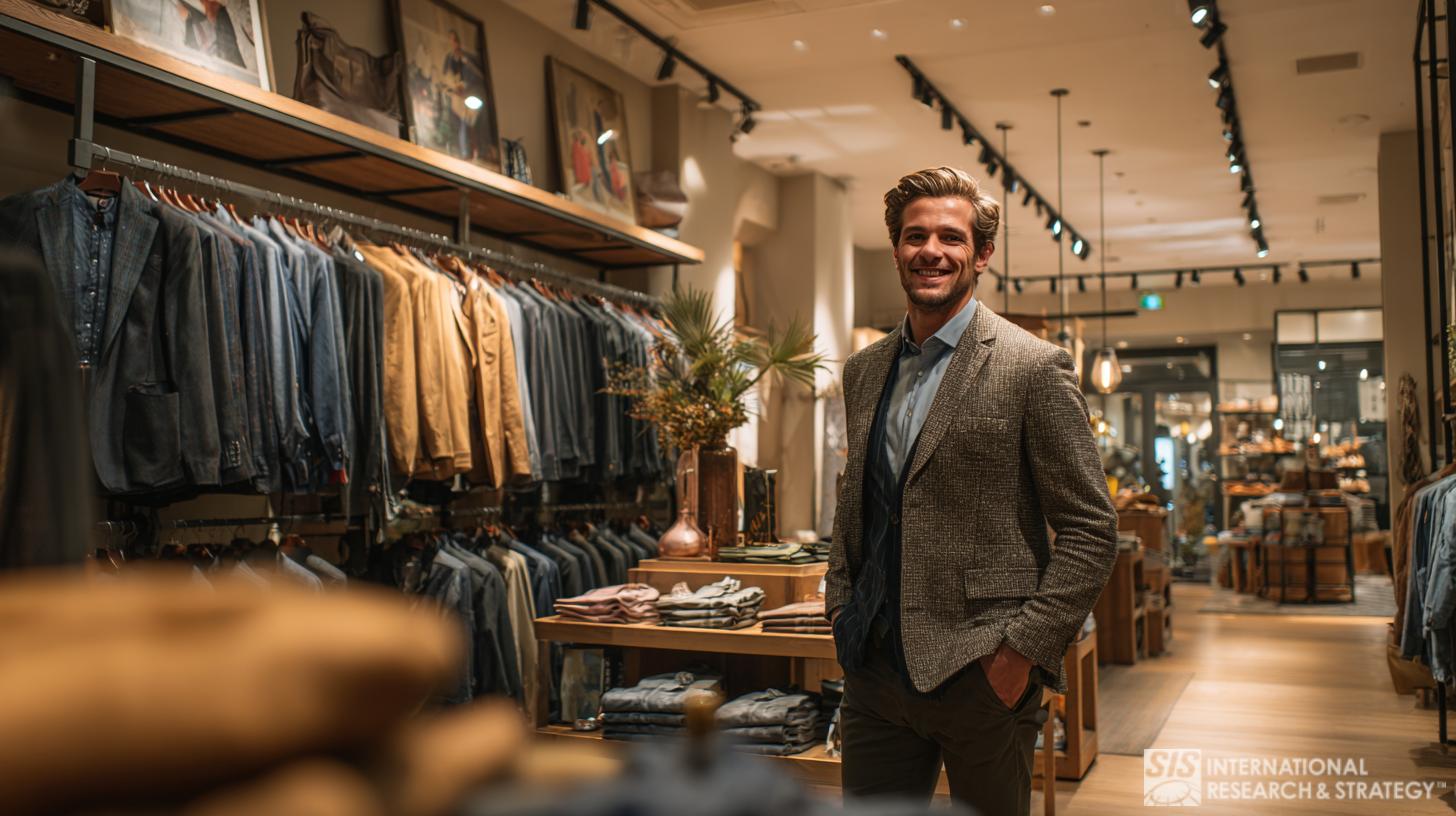
The future of retail moves too fast for traditional market research approaches. You need real-time insights that inform immediate decisions.
Strategic market research acts like the company’s early-warning siren, screaming alerts when buyer habits shift or new rivals jump into view. One-off surveys that look backward no longer cut it; leaders crave a live feed that flashes trends the moment they appear.
Savvy executives blend old-school مجموعات التركيز with faster signals: they scour social chatter, track thumb-driven app habits, and run predictive models until they see buyer moods even before the shoppers do. This patchwork of methods serves up a steady stream of intel on who loves what, who is priced out, and where white space lurks.
The real trick lies in shoving those findings straight into the places where choices are made, not stuffing them into PowerPoints for next quarters review. Raw data becomes urgent fuel for tweaking product specs, flipping ad copy, adjusting tabs, or polishing the supply line.
To make it work, everyone in the room-engineers, data wranglers, marketers, and plant chiefs-has to speak a common language and move as one. When a signal lights up, they either act fast or risk watching competitors scoop the reward.
How Market Research Investments Pay for Themselves
Strategic research, when done right, pays for itself almost overnight. A leading home-improvement chain dug deep into shopper habits last spring, trying to read the DIY pulse amid the market wobble. The numbers startled even the data team: shoppers were ditching grand remodels and lining up instead for paint, hinges, and weekend fixes that lifted a room’s mood by sundown.
The retailer flipped its approach in record time. Shelves got shuffled, aisles displayed quick-wins rather than lumber yard projects, and the ads started promising instant gratification instead of epic makeovers. Half a year later, the bottom line was more than a pretty graph; sales in the refreshed aisle climbed by double digits, foot traffic jumped, and stock turned fast enough to keep warehouses guessing.
- 18% increase in average transaction frequency
- 24% improvement in customer satisfaction scores
- 31% boost in profit margins on high-velocity products
- 15% reduction in inventory carrying costs
Within three months, the original research outlay had come back in full, the recovery coming almost entirely from faster inventory turns and a noticeable bump in the average lifetime value of each customer. Perhaps of greater consequence, the fresh market insights pushed the company to center stage in a conversation its rival firms never bothered to join-small, repeated fixes homeowners suddenly craved.
Note: While this story is based on real strategies we’ve employed, specific client details have been tweaked to respect confidentiality.
Figure 4. Global E-commerce Sales Growth Trajectory
Global E-commerce Sales Growth Trajectory
Growth Phase Analysis
Strategic Insight: E-commerce is transitioning from explosive pandemic-driven growth to sustainable long-term expansion. The $3.1 trillion increase over six years represents the largest retail channel shift in history, requiring businesses to fundamentally reimagine their digital capabilities and customer experience strategies.
What Are the Opportunities and Challenges?
The future of retail will create unprecedented opportunities alongside complex challenges. Smart executives understand both sides of this equation.
فرص
✔️ First movers still get the first choice. Augmented reality, voice-activated payments, and scattered IoT sensors let shoppers touch, talk to, and feel the merchandise without ever stepping inside a store. Sustainability badges- fair trade, carbon offset, and ocean-plastic reinforce a brand image and let the register ring a little louder.
✔️ Digital highways now flatten the map overnight. A live video drop-in can beta-test a lawn-care kit in Omaha, Bucharest, or Lima before breakfast, and the inbox report from that experiment lands before lunch.
✔️ Machine-driven tweaks and cloud-connected workflows quietly squeeze costs and lift profit margins. The savvy retailers are routing spare cash toward systems that cut excess and letting their people concentrate on the parts of work that actually feel human.
التحديات
🔹Of course, no victory laps come without a few potholes. Tightening privacy rules make even the simplest data swag bag look like a legal maze. Advertising space is auctioned off every minute, so grabbing attention now costs more than it did last year and the year before that. On top of that, customers still expect their orders to arrive in days, if not hours, while demanding that each shipment tread lightly on the planet.
🔹Upgrading the tech stack usually means a six-figure cash outlay and a learning curve that many legacy merchants simply dont have.
🔹Barriers that once protected household-name brands are getting knocked down faster than anyone expected. A garage startup can sign up for a white-label shipping service tonight and be selling direct to consumers by breakfast, so the incumbents can no longer hide behind bigger warehouses or thicker catalogs.
Future of Retail Success Stories
Three case studies demonstrate how forward-thinking retailers are already winning in tomorrow’s market.
AI-Powered Fulfillment Revolution
A well-known big-box chain recently rewired its entire operation by spinning up an AIdriven fulfillment web that effectively doubled as a retail media powerhouse. Predictive math on stock flows, paired with hands-free inventory oversight, gave the company a staying edge that most smaller players simply can’t mirror.
Numbers from the field tell the story: shelf shortages dipped 27 percent, order-to-door transit shrank by a third, and money from brands renting ad space shot up 41 percent. Best of all, shoppers noticed smoother aisles, faster pickups, and quieter phones during peak rushes.
What really tilts the game is the way many stores now act as neighborhood order hubs that pick, pack, and hand off goods for online buys, walk-in carts, and curbside pauses all at once. The writing on retails wall is clear: whoever uses their footprint most freely while keeping the checkout fuss to a whisper walks away a winner.
Digital Direct-to-Consumer Ecosystem
A well-known athletics brand chose to skip the usual rack-and-counter deals, so it stitched a full-on digital playground where shoes, sweat, and street chatter all meet. The companys app flipped from order pad to lifestyle hub, pulling users back for fresh content long after the payment screen disappears.
Numbers on the dashboard tell a direct story: nearly nine in ten dollars now flow through the brands own outlets, the worth of a typical customer climbed 52 percent, and the gauge on loyalty ratings jumped 38 points. By cutting loose from third-party sellers, the company kept its share rising and avoided the usual trade-off.
Product smarts paired with community spirit drove the shift, and the data pipes behind the scenes tailor everything-warm-up videos, gear picks, even local runs-to each phones owner. Call it a preview of retails next chapter: brands that plant themselves in daily routines become as invisible and indispensable as a trusted pair of sneakers.
Tech-Enabled Hyper-Personal Beauty Journey
A premium beauty chain began letting shoppers try on lipstick, eyeliner, or foundation in real time with the swipe of a finger. Equity partners called it the tech-and-makeup mash-up nobody knew they needed, because the screens never drown out the advice from a live consultant.
Visitors noticed they spent a little more on each pass, stayed longer, and picked up the app that same night. That spike in commitment-43 percent on ticket size, 29 percent for repeat visits, 56 percent for the rewards circle-caught even the financial analysts off-guard.
Behind the light show, the software quietly logs colors, tones, and product gaps to fire off slick video guides and refill nudges. Merchants now talk about a future where instinct and silicon act like old friends in the same room, each lending the other strength neither had on its own.
ملحوظة: While these stories are based on real strategies we’ve employed, specific client details have been tweaked to respect confidentiality.
Inside the Future of Retail Toolbox
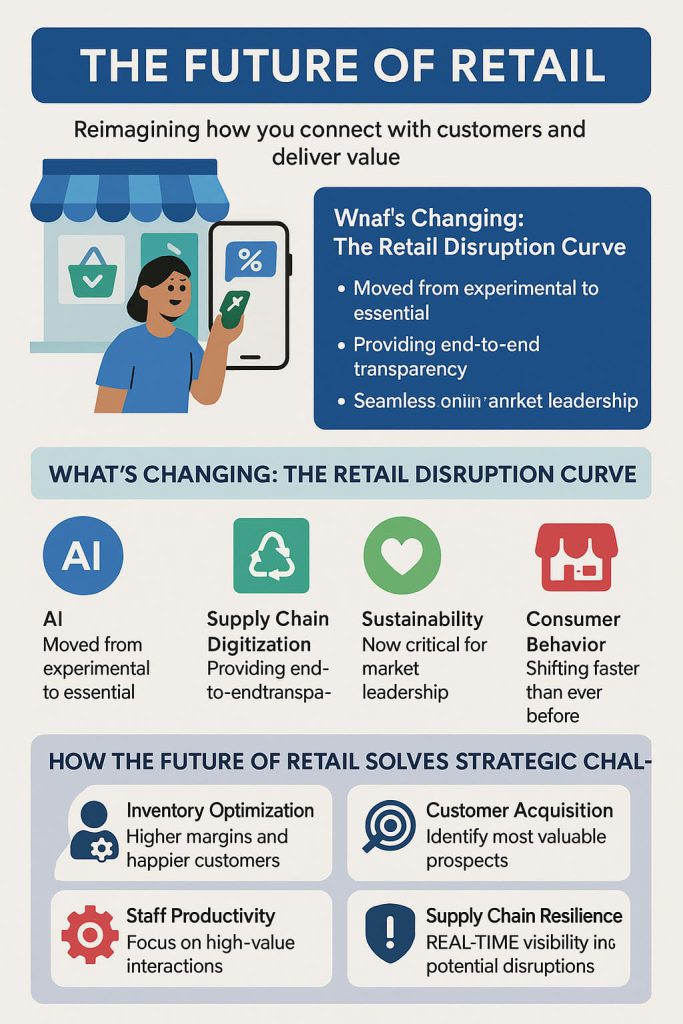
Key Insights You Can’t Afford to Miss
✅ Omnichannel Integration – Create seamless experiences across all touchpoints where customers interact with your brand, ensuring consistency and continuity
✅ AI-Powered Personalization – Deploy machine learning to deliver individualized product recommendations, pricing, and marketing messages at scale
✅ Real-Time Inventory Management – Set up systems that track products from manufacturing to customer delivery, enabling accurate availability and rapid fulfillment
✅ Voice and Visual Commerce – Prepare for shopping through smart speakers, augmented reality, and image recognition technologies that simplify purchasing
✅ Sustainability Tracking – Use transparency tools that measure and communicate environmental impact to meet growing consumer demand for responsible business practices
✅ Community Building Platforms – Create digital spaces where customers connect with each other around shared interests related to your products or brand values
✅ Performance Marketing Analytics – Track customer acquisition, engagement, and lifetime value across all marketing channels to optimize spending and improve ROI
✅ Automated Customer Service – Deploy chatbots and AI assistants that handle routine inquiries while escalating complex issues to human representatives
What Makes SIS International a Top Choice for the Future of Retail Research?
Why leader retailers choose our expertise:
- نهج مخصص – We design research methodologies specifically for your retail challenges, competitive landscape, and growth objectives rather than using one-size-fits-all solutions
- 40+ Years of Experience – Our track record spans 135+ countries with 150+ employees and collaborators, serving 70% of Fortune 500 companies across diverse retail sectors and market conditions
- Global Databases for Recruitment – We access extensive networks of consumers, B2B decision-makers, and industry experts worldwide to ensure research participants represent your target markets accurately
- Projects Get Done Fast – Our streamlined processes and international presence enable rapid research execution without compromising quality or depth of insights
- Affordable Research – We deliver enterprise-level research capabilities at costs that make strategic intelligence accessible for major initiatives and ongoing market monitoring
- Strategic Consulting Integration – Our research insights connect directly to actionable business strategies rather than academic reports that sit on shelves
- Technology-Enhanced Methodologies – We combine traditional research rigor with modern analytics tools to provide deeper insights into the future of retail trends
Frequently Asked Questions About The Future of Retail
How quickly will AI transform retail operations?
AI transformation in retail happens in waves rather than overnight revolution. Core applications like inventory optimization and basic personalization are already mainstream, with most major retailers implementing these capabilities within 12-18 months. Advanced applications like predictive customer service and autonomous supply chain management require 2-3 years for full deployment. The future of retail will see AI becoming ubiquitous, but smart retailers focus on high-impact use cases first rather than trying to automate everything simultaneously.
What role will physical stores play in the future of retail?
Physical stores won’t disappear – they’ll evolve into experience centers, fulfillment hubs, and community gathering spaces. The future of retail sees stores becoming more valuable, not less, as they serve multiple functions that pure e-commerce can’t replicate. Successful retailers use physical locations for product demonstrations, immediate gratification, social experiences, and local market presence.
How important is sustainability in retail’s future?
Sustainability has moved from nice-to-have to must-have for retail success. Younger consumers actively avoid brands that don’t demonstrate environmental responsibility, and this trend is accelerating across all demographics. The future of retail requires authentic sustainability commitments backed by measurable actions and transparent reporting.
However, sustainability can’t just be a marketing message – it needs to be integrated into supply chain decisions, product development, and operational practices.
What technologies should retailers prioritize for investment?
Customer data platforms should be the foundation of any retail technology strategy, as they enable personalization, inventory optimization, and marketing effectiveness across all other investments. The future of retail depends on unified customer intelligence that informs every business decision.
After establishing strong data capabilities, retailers should prioritize AI-powered personalization engines, omnichannel inventory management, and automated customer service solutions. These technologies provide immediate ROI while building capabilities for more advanced applications like predictive analytics and autonomous operations.
How will customer expectations change in the next few years?
Customer expectations will continue shifting toward immediate gratification, perfect personalization, and seamless experiences across all touchpoints. The future of retail must accommodate customers who expect Amazon-level convenience, Netflix-quality personalization, and Apple-standard design from every brand they interact with.
What are the biggest risks facing traditional retailers?
The biggest risk is underestimating the speed of change and making incremental improvements when fundamental transformation is required. Traditional retailers often have legacy systems, established processes, and organizational cultures that resist the agility needed for the future of retail.
Competition from digital-native brands and platform companies poses ongoing threats, as these competitors don’t have legacy constraints and can implement new technologies faster. Traditional retailers must leverage their existing advantages – brand recognition, supply chain scale, customer relationships – while building new capabilities that match digital competitors’ agility and innovation.
How should retailers measure success in the changing landscape?
Traditional metrics like same-store sales and inventory turns remain important but need to be supplemented with new measurements that reflect the future of retail realities. Customer lifetime value, cross-channel engagement, and brand sentiment provide better insights into long-term business health than quarterly sales figures alone.
Digital engagement metrics, personalization effectiveness, and sustainability performance are becoming equally important for measuring retail success. Smart retailers track leading indicators that predict future performance rather than just reporting historical results.
موقع منشأتنا في نيويورك
11 إي شارع 22، الطابق 2، نيويورك، نيويورك 10010 هاتف: 1(212) 505-6805+
حول سيس الدولية
سيس الدولية يقدم البحوث الكمية والنوعية والاستراتيجية. نحن نقدم البيانات والأدوات والاستراتيجيات والتقارير والرؤى لاتخاذ القرار. نقوم أيضًا بإجراء المقابلات والدراسات الاستقصائية ومجموعات التركيز وغيرها من أساليب وأساليب أبحاث السوق. اتصل بنا لمشروع أبحاث السوق القادم.

